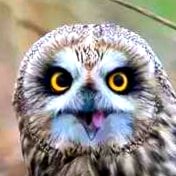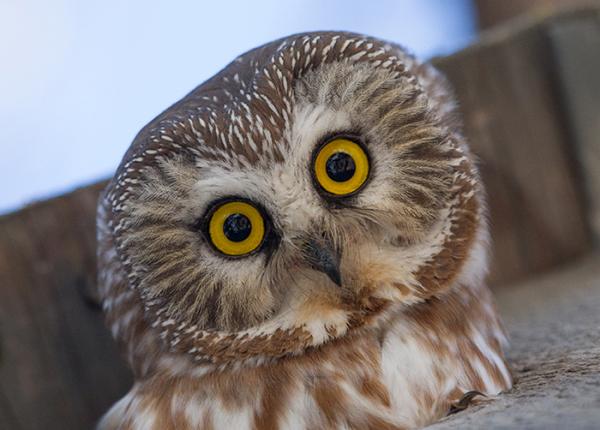From The Morning Sun (Paywalled)
February 17, 2025
An Alma-area woman who travels across Michigan and other states to photograph wildlife was surprised recently to see an unusually-colored snowy owl.
While photographing wildlife in eastern Michigan, Julie Maggert spotted a snowy owl with orange coloring on some of its feathers, leaving her to wonder whether it was a rare pigmentation or something else.
Maggert, who also travels to other countries to photograph wildlife, enjoys finding snowy owls during the winter as the birds migrate south from the Arctic regions of North America and Eurasia if food is scarce.
Having focused on photographing migrating birds, deer, elk, other wildlife, flowers and the Aurora Borealis, Maggert had never seen an orange snowy owl before, and took several photos of the bird perched and in flight.
Naming the bird “Creamsicle,” Maggert became obsessed, digging up information and researching, and started her journey with a two-hour drive the eastern part of Michigan, hoping just to see the unusual owl.
After six hours of waiting, she was only able to get photos of the bird from hundreds of yards away.
Nine hours into the wait, the owl flew to what Maggert later learned was one of her favorite spots – a tree on a ditch line that was still too far away to capture a good image.
“At very last light, she went hunting and flew out of sight back into the field,” Maggert said. “On the way home, I was quiet and felt gutted.”
Determination won out, and Maggert went back for what she thought would be the final trip to the owl’s location in eastern Michigan.
After searching for Creamsicle where she was previously, the bird was gone so Maggert continued looking and something caught her eye that looked like a child’s bouncy ball.
Looking through binoculars, she discovered it was Creamsicle, much closer to the road behind a clump of dirt.
“Now my adrenaline is pumping, and it’s game time,” Maggert wrote in an email to the Morning Sun. “I parked the truck and waited some more.
“Patience is the key to this game. Once I was parked, other people started to realize what I was doing and parked along the road as well.
Worrying that the bird would get spooked, Maggert was relieved when the other motorists lost interest and drove off.
Creamsicle flew back to her perch, giving Maggert a chance to take some photos.
A few days later, still thinking about the strangely colored owl, Maggert debated the pros and cons before going back to the location – making the total time working on photographing the bird 900 miles of driving, 28.5 hours of sitting in her truck waiting and looking with binoculars, and 16 hours of driving back and forth to the location.
“This would be my very last chance for a few weeks as I have other obligations,” Maggert wrote. “In a few weeks, who knows what could happen to her?
“She could head back north, get spooked far away or worse, get hit by a vehicle. I didn’t want to chance any of that. So I decided to head back over to the location. I felt that this would be a total Hail Mary.”
Maggert returned, driving around looking for the bird and came up empty-handed after a few hours.
Because she was so far from home and didn’t want to leave without seeing the owl, Maggert parked and waited.
“Once I’m there, I make it a day trip,” she wrote. “I ventured out to look around one more time, and there she was, on top of a pole.”
Maggert’s dream of photographing the owl was dashed momentarily because the bird was on a “less than attractive” utility pole but she eventually flew off to a “cleaner” pole and Maggert got her shots.
Two mid-Michigan area wildlife experts had ideas about why the owl has orange coloration.
Michigan Department of Natural Resources Lt. Jeremy Payne consulted with DNR Wildlife Biologist Bruce Barlow, who said some Canadian wildlife agencies spray paint snowy owls in Canada to mark them on airport runways as part of “Project SNOWStorm.”
Barb and Joe Rogers, who own the Wildlife Recovery Association in Midland County, believe the owl was marked with paint.
Many owls are desperate for food this time of year, and will seek out mice in barns, Barb said.
“The owl may be marked to see if it continually enters the same barn, or is traveling to other barns,” Barb said. “There may be a concern about the owls spreading avian flu.”
While Maggert said there has been speculation that the orange in the bird’s feathers might be a color mutation or came from runway de-icing spray at an airport, “she is a once in a lifetime beauty and seemingly healthy.”
Project Snowstorm has been adamant this is NOT the type of work they do or support.
Here is the actual story of what they are mentioning.
From The Wildlife Society
Biologists to test impact of auxiliary markings on snowy owl
March 7, 2016
Recently, a Wildlife Services biologist captured a snowy owl at the Detroit Metropolitan Wayne County Airport. When released, the owl carried a USGS leg band and was the first participant in a three-year research study in cooperation with the U.S. Geological Survey Bird Banding Lab.
Red-tailed hawks have shown no problems when outfitted with lightweight patagial wing tags, which makes identification of hawks returning to the airport easy for airport biologists. USGS, however, doesn’t have sufficient information on how patagial tags would impact snowy owls. Wildlife Services biologists at Michigan and Illinois airports come into regular contact with wintering snowy owls. They will work with National Wildlife Research Center research wildlife biologist Dr. Brian Washburn in partnership with USGS to evaluate three auxiliary marking techniques for ease of identification and impact on the owls.
Birds in the study will be marked in one of three ways: just a federal leg band; a band and marking with nontoxic paint; or a band and two patagial wing tags (white with a black letter and number). Over three years, any returning owls that are recaptured will undergo a physical examination to determine any impact of the markings.
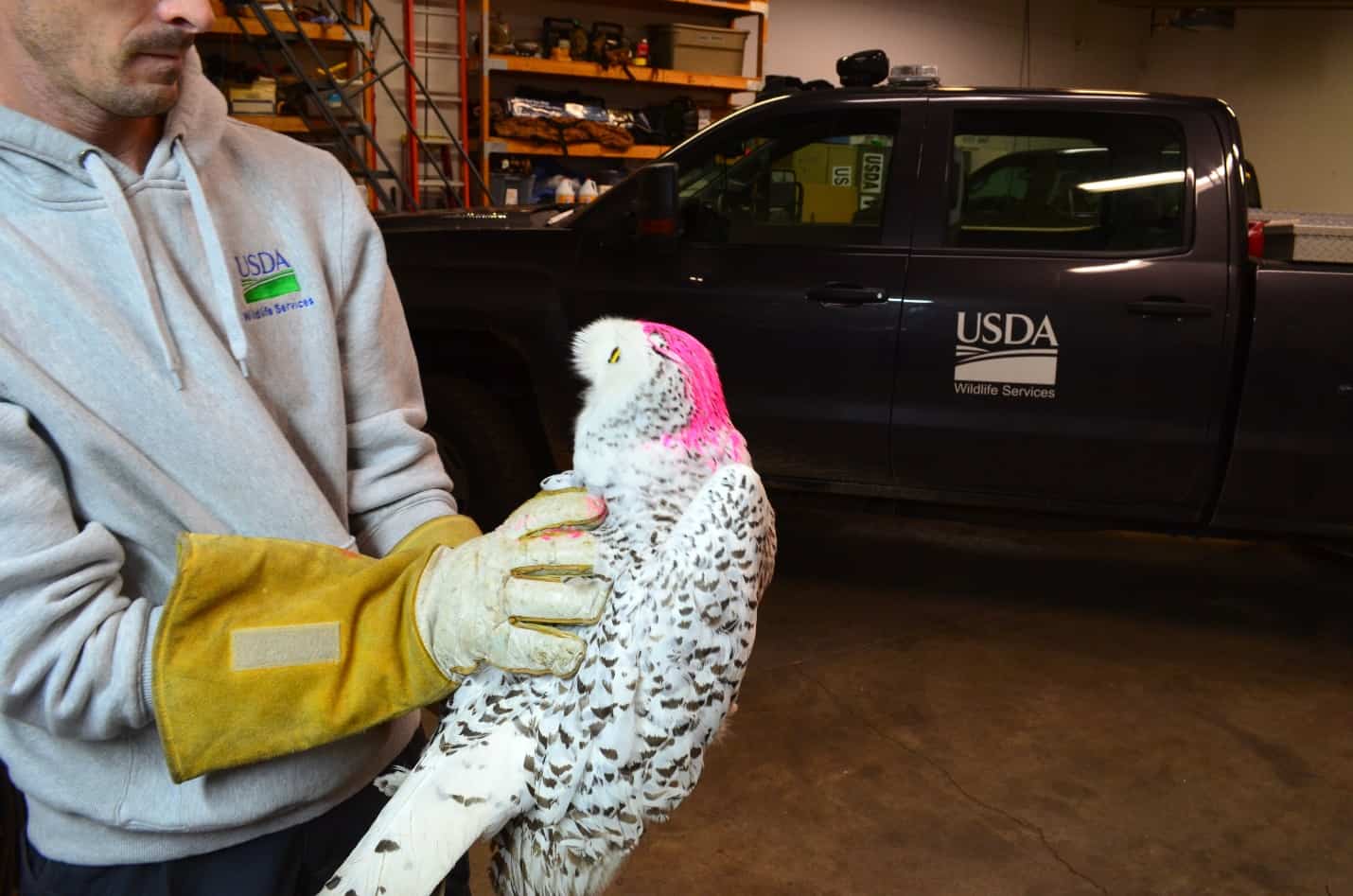
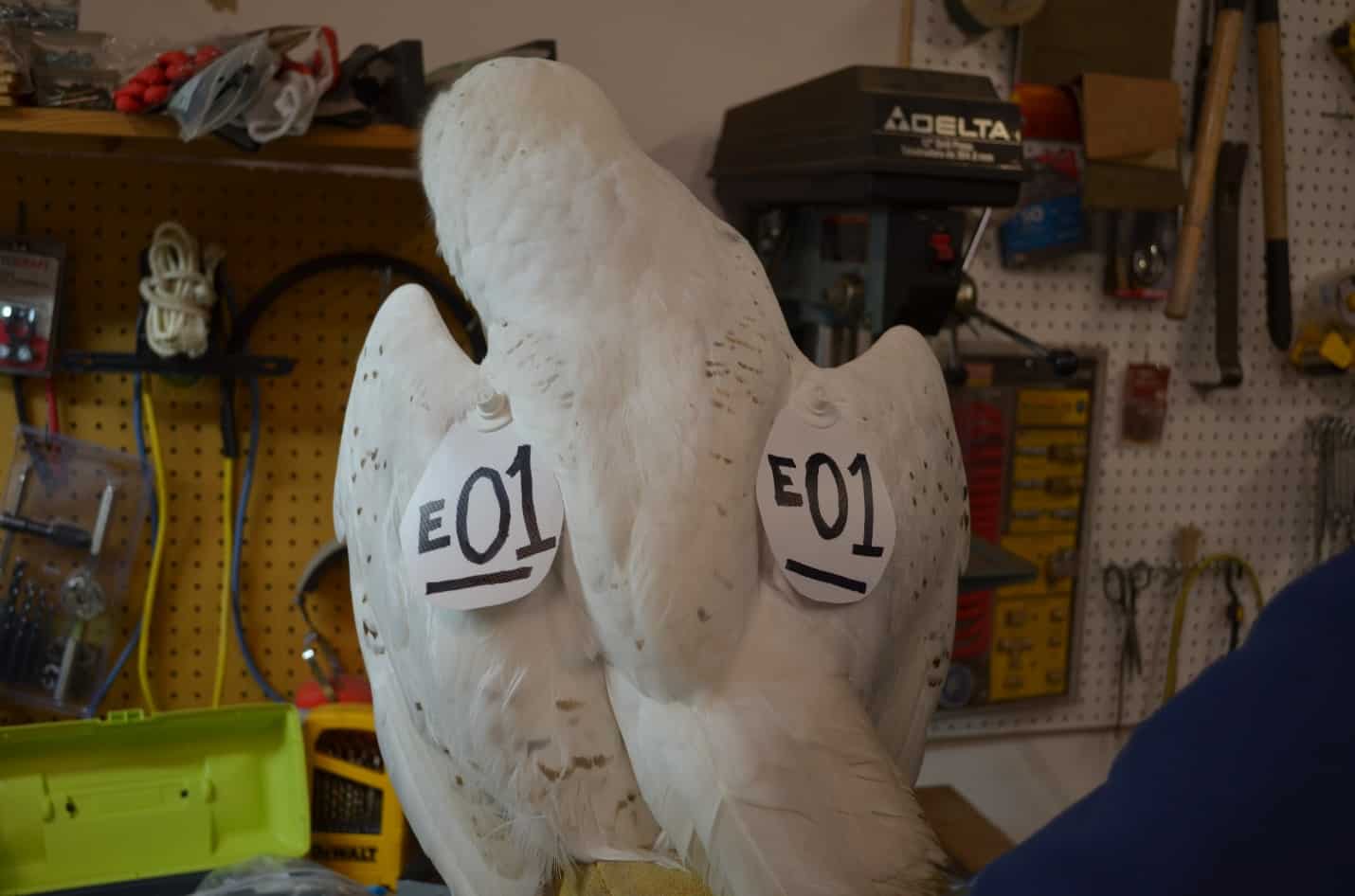
The patagium is a membrane of skin connecting the shoulder and wrist. A rivet is put through here like an ear piercing with the tag attached. You can see the patagium (a little scuffed up here, this is post-surgery to an injury here) on our lovely patient. I highlighted the bones in white, and the yellow is the patagium.
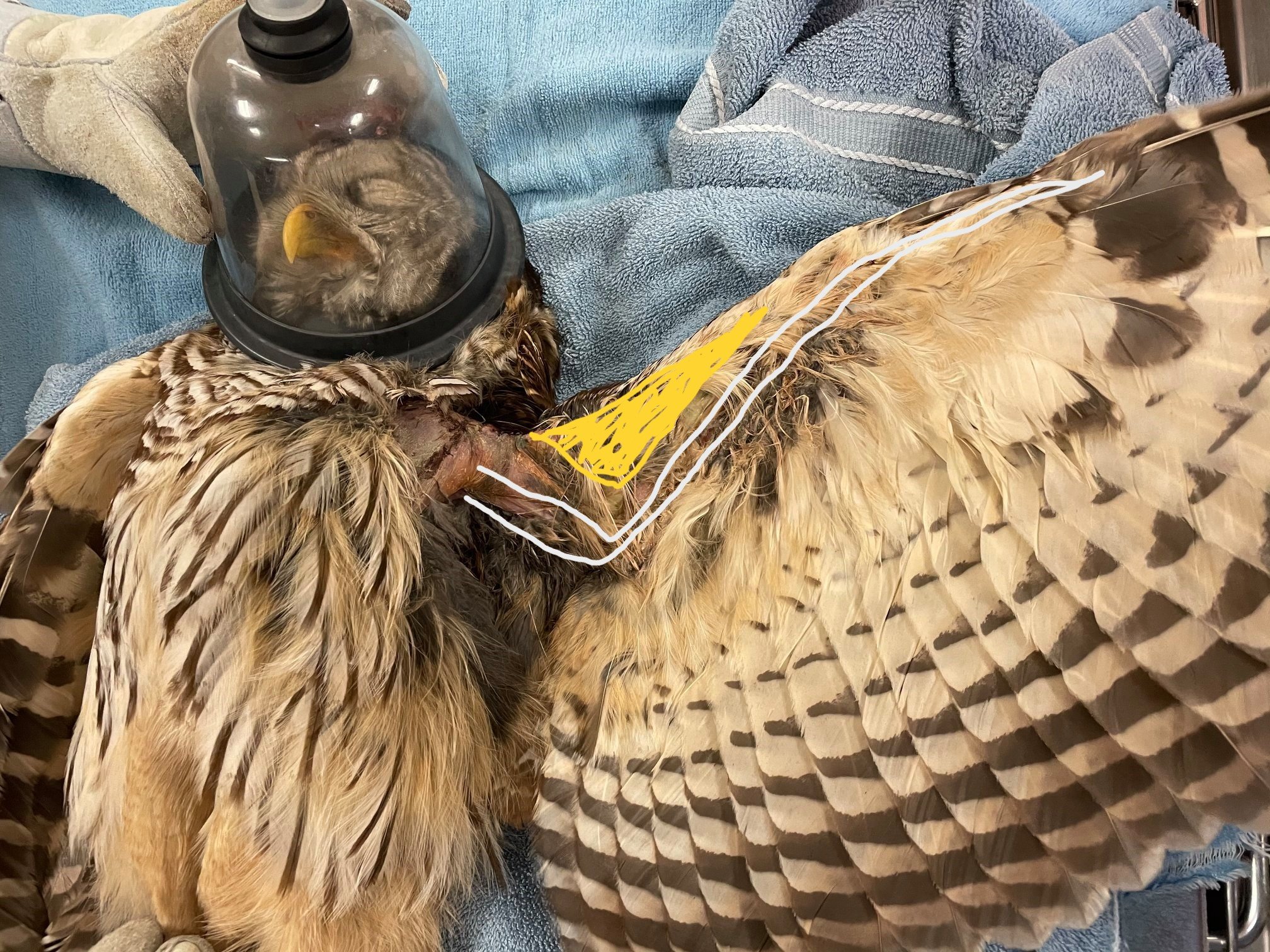
There are a few types of tags. This example has a flap to wrap around the wing, but the ones on the Snowy above and on vultures I have seen don’t have the flap.
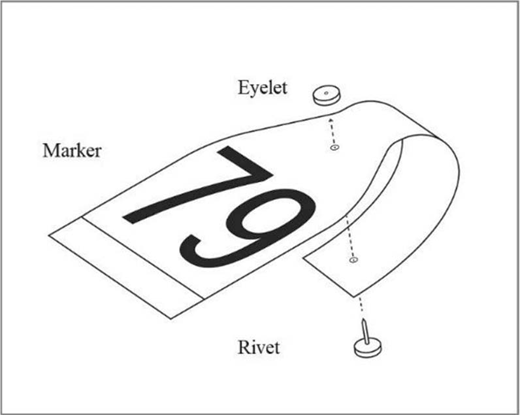
They are used on birds so they can be tracked without being recaptured to look at a leg band. The tags have numbers large enough to be seen through binoculars/spotting scope/etc.
There is ongoing debate as to the pro/con of this method of tracking birds, as some think they cause issues to the birds.
Here is a video of people tagging and putting a transmitter on a condor that goes over the anatomy and proper procedure to keep the bird safe.
The bird has already been pierced so you don’t need to watch it get poked, but it does look a little weird if you’re easily creeped out.
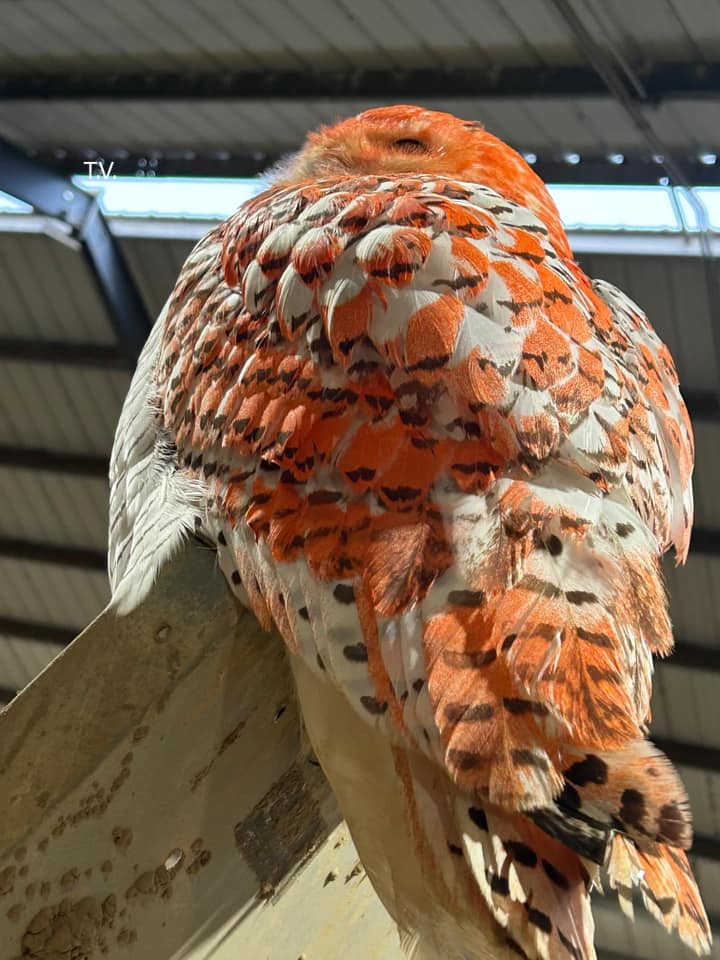 .
.A Facebook user sent this photo her husband took at his work to Project Snowstorm’s page.
This is so crazy. This picture looks just like the OP… please tell me this could still be the same single snowy and this isn’t becoming a thing people do to snowies…
I believe it is the same. This picture is older, around the time of this owl’s original discovery. It looks to have about the same distribution of color, though none of the other pics have the same angle. Owls are hard to sneak up on, but they can be baited and trapped.
It looks almost like diagonal stripes in this pic, like it pressed up on a grate or something. What a mystery!
Well, I am glad(?) it just seems to be the one. Did anything come of the idea that it could be deicing solution from a plane? I kind of checked out of this drama for a bit.
It’s the second time I’ve heard it mentioned, but all the quotes seem to be coming from a small group of people without much source citing, so it may just be the same quote over again. I had been hoping this article had an actual answer after finding a way around the paywall to read the dang story, but in the end, I got nothing new except some stories behind the taking of the photo.
Well, I appreciate your perseverance! I certainly hope we get some kind of resolution, or at least the color wears off and we all just forget about it. I really don’t want this to become a trend.
I don’t know who would hurt a Snowy, but I guess I could say the same about sugar, cats, etc. 😞
Flaming Hot Cheetos, obviously.
Noooo! Too spicy! It’s right in the face! 😱
Creamsicle is a great name lol
deleted by creator
The title: “[Is] The mystery of [the] orange snowy owl solved?”
Betteridge’s law of headlines is an adage that states: “Any headline that ends in a question mark can be answered by the word no.”
Overall: is the mystery solved? - NO
Is it a mutation? NO, I haven’t heard anything from any biologists or rescue people being excited to discover some rare variant.
Was it done purposely? NO, it would be hard to catch the owl, and I feel there’s some sort of striping pattern to most of it.
Is it paint or deicer? Likely NO, Paint doesn’t seem likely as it isn’t thick or has really gunned up the feathers. Some said most deicer is blue, but others claim to have seen orange. If it was one of these, I feel we would have some leads, or we’d have seen other birds at some point being orange.
It may turn out to be one of those things, but I wouldn’t put money on it, and the article did not sway me to think otherwise.
